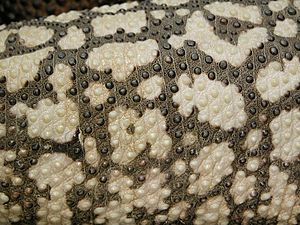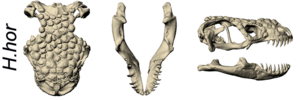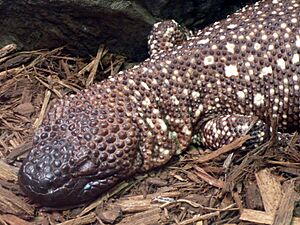Mexican beaded lizard facts for kids
Quick facts for kids Mexican beaded lizard |
|
|---|---|
 |
|
| At Zürich Zoologischer Garten | |
| Conservation status | |
| Scientific classification | |
| Genus: |
Heloderma
|
| Species: |
horridum
|
| Synonyms | |
|
|
The Mexican beaded lizard (Heloderma horridum) is a type of lizard found mainly in Mexico and southern Guatemala. It belongs to the family Helodermatidae. This lizard is one of the few lizards known to be venomous.
The Mexican beaded lizard is bigger than its cousin, the Gila monster. It has a duller color, mostly black with yellowish stripes. Scientists are still debating why it uses its venom, especially since it mostly eats eggs. However, its venom has special chemicals that are helpful for making medicines. These medicines can be used to treat diseases like diabetes.
Sadly, the Mexican beaded lizard is facing threats. People sometimes collect them illegally, and their homes are being destroyed. Because of this, it is a protected species. One type, the Guatemalan beaded lizard, is very rare. There are fewer than 200 of them left in the wild.
Contents
About the Mexican Beaded Lizard
The beaded lizards are related to the Gila monster. They also have many relatives that lived long ago, going back to the time of the Cretaceous period. The group of lizards called Heloderma has been around for a very long time. Because they haven't changed much over millions of years, some people call them "living fossils."
The scientist Arend Friedrich August Wiegmann first described this lizard in 1829. He first named it Trachyderma horridum. Six months later, he changed its name to Heloderma horridum. The name Heloderma means "studded skin." This comes from ancient Greek words for "nail head" and "skin." The word horrĭdum is Latin for "rough."
What Does It Look Like?
Adult beaded lizards can grow to be about 57 to 91 centimeters (22 to 36 inches) long. They are much larger than the Gila monster. Gila monsters only reach about 30 to 56 centimeters (12 to 22 inches) in length. The average weight of an adult beaded lizard is about 800 grams (1.8 pounds). Some very large ones can weigh over 2000 grams (4.4 pounds). The heaviest known was 4000 grams (8.8 pounds).
Both male and female beaded lizards look similar. They are stocky with wide heads. Their scales are small and look like beads. They do not overlap. Most of their scales have bony plates underneath them. These bony plates are called osteoderms.
Their main color is black. They have different amounts of yellow spots or bands. Beaded lizards have short tails. They use their tails to store fat. This fat helps them survive when they are resting for months. Unlike some other lizards, their tail does not grow back if it breaks off.
Beaded lizards have pink, forked tongues. They use their tongues to smell things. They stick their tongue out to collect smells from the air. Then they touch their tongue to a special organ inside their mouth. This organ is called a Jacobson's organ.
Where Do They Live?
Beaded lizards live in areas near the Pacific Ocean. Their range goes from southern Sonora in Mexico to southwestern Guatemala. They also live in two areas near the Atlantic Ocean. These areas are from central Chiapas to southeastern Guatemala.
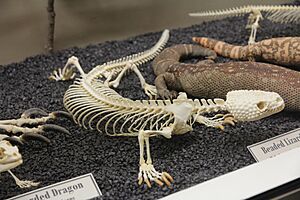
They mostly live in deserts, tropical forests, and thorn scrub forests. But they can also be found in pine-oak forests. They live from sea level up to 1500 meters (about 4900 feet) high. In the wild, these lizards are only active from April to mid-November. They spend about an hour each day above ground.
There are different types of Mexican beaded lizards.
- The Mexican beaded lizard (H. horridum) lives in Mexico.
- The Rio Fuerte beaded lizard (H. exasperatum) lives in southern Sonora and northern Sinaloa.
- The Chiapan beaded lizard (H. alvarezi) lives in northern Chiapas and parts of Guatemala.
- The Guatemalan beaded lizard (H. charlesbogerti) is found only in the dry valley of the Río Motagua in northeastern Guatemala. This type is very rare. Fewer than 200 are thought to be left in the wild.
What Do They Eat?
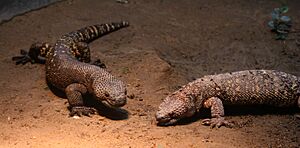
The beaded lizard is a special hunter. It mainly eats the eggs of birds and other reptiles. It can climb trees to find nests and search for prey. Sometimes, it also eats small birds, mammals, frogs, lizards, and insects.
In zoos, beaded lizards are often fed small animals like mice and rats. If a lizard is caught from the wild, zookeepers might put egg on the food. This helps the lizard start eating in its new home.
How Does Their Venom Work?
The venom glands of the beaded lizard are in its lower jaw. These glands are like special salivary glands. Each gland has a tube that leads to the base of its grooved teeth. When the lizard bites, it holds on tightly to its victim. It chews to get its venomous saliva into the wound. Its jaw grip is strong. However, its teeth are not set deeply, so they can break off easily.
The beaded lizard's venom is a weak type of poison. It affects blood. Deaths in humans are rare, but it can cause breathing problems. The venom has many parts. These parts include different enzymes and chemicals. The venom does not cause blood to clot. Almost all human bites have happened when people poked captive lizards.
The venom affects animals differently. For small animals like rats, it can cause blood pressure to drop quickly. It can also cause breathing problems and heart issues. Other effects include swelling and internal bleeding. In humans, bites cause extreme pain. This pain can spread far from the bite area. It can last for up to 24 hours. Other common effects are swelling, weakness, sweating, and a quick drop in blood pressure. Beaded lizards are not affected by their own venom.
Some chemicals in the venom are useful for medicine. They might help treat diabetes, Alzheimer's disease, and even HIV. One chemical, called exendin-3, is used to make a drug called exenatide. A study in 1996 found that this chemical might also stop the growth of some cancer cells.
Life Cycle
Beaded lizards can start having babies when they are about 3 years old. They usually mate during the summer months. In zoos, they can breed any time of the year. Male lizards will fight each other. These fights can last for several hours. The winner gets to mate with the female.
Females usually lay two to 30 eggs. This happens in late summer or early fall. The eggs hatch the next spring or summer. Young lizards are rarely seen. Scientists think they spend most of their early lives underground. They come out when they are about 2 or 3 years old, after they have grown quite a bit.
Protecting the Beaded Lizard
Many myths and superstitions surround the beaded lizard in its home areas. For example, some people wrongly believe it is more venomous than a rattlesnake. Others think it can cause lightning strikes with its tail. Some even believe it can harm a pregnant woman just by looking at her. Because of these false beliefs, local people often kill the lizard when they see it.
The Mexican government protects the beaded lizard. It lives in several protected areas. In Guatemala, it is also protected by law. It is listed under CITES, which helps control international trade of endangered animals.
The Guatemalan beaded lizard (H. charlesbogerti) is very endangered. There are fewer than 200 of them left in the wild. Their habitat is being destroyed for farming. A group called Project Heloderma is working to save them. Many organizations are part of this effort. They have successfully gotten the Guatemalan government to make it illegal to export this lizard.
External Links
- IRCF's Guatemalan Beaded Lizard Conservation Project
- Mexican Beaded Lizard at the LA Zoo
- Mexican Beaded Lizard at the Saint Louis Zoo
- Protecting Guatemalan beaded lizards: Conservation Heloderma



